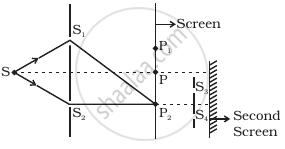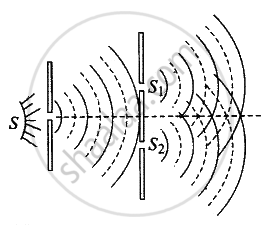Advertisements
Advertisements
Question
Figure shows a standard two slit arrangement with slits S1, S2, P1, P2 are the two minima points on either side of P (Figure). At P2 on the screen, there is a hole and behind P2 is a second 2-slit arrangement with slits S3, S4 and a second screen behind them.

Options
There would be no interference pattern on the second screen but it would be lighted.
The second screen would be totally dark.
There would be a single bright point on the second screen.
There would be a regular two slit pattern on the second screen.
Solution
There would be a regular two slit pattern on the second screen.
Explanation:
Every point on the given wave front acts as a source of new disturbance called secondary wavelets which travel in all directions with the velocity of light in the medium.
A surface touching these secondary wavelets tangentially in the forward direction at any instant gives the new wavefront at that instant. This is called secondary wavefront. In the given question, there is a hole at point which is a maxima point. From Huygen’s principle, wave will propagate from the sources S1 and S2. Each point on the screen will act as secondary source of wavelets.

The wavefront emitted by a narrow source is divided into two parts reflection, refraction or diffraction. The coherent sources so obtained are imaginary.

APPEARS IN
RELATED QUESTIONS
Using Huygens's construction of secondary wavelets explain how a diffraction pattern is obtained on a screen due to a narrow slit on which a monochromatic beam of light is incident normally.
The refractive indices of water and diamond are `4/3` and 2.42 respectively. Find the speed of light in water and diamond. (c = 3x108 m/s)
Using this principle draw a diagram to show how a plane wave front incident at the interface of the two media gets refracted when it propagates from a rarer to a denser medium. Hence verify Snell's law of refraction.
State Huygens’s principle. Show, with the help of a suitable diagram, how this principle is used to obtain the diffraction pattern by a single slit.
Draw a plot of intensity distribution and explain clearly why the secondary maxima becomes weaker with increasing order (n) of the secondary maxima.
Define the term wavefront. Using Huygen’s wave theory, verify the law of reflection.
Define a wavefront. Using 'Huygens' principle, draw the shape of a refracted wavefront, when a plane wave is incident on a convex lens.
What is the phase difference between any two points lying on the same?
Is Huygen’s principle valid for longitudinal sound waves?
Consider a point at the focal point of a convergent lens. Another convergent lens of short focal length is placed on the other side. What is the nature of the wavefronts emerging from the final image?
What is the shape of the wavefront on earth for sunlight?
